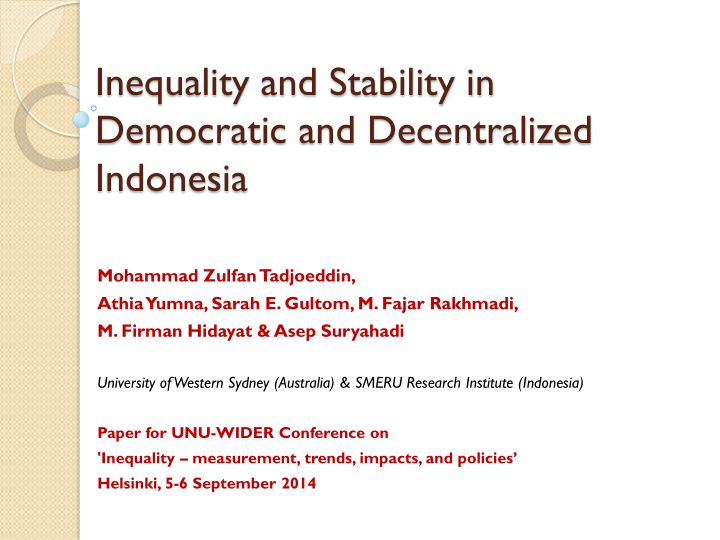



Inequality and Stability in Democratic and Decentralized Indonesia Mohammad Zulfan Tadjoeddin, Athia Yumna, Sarah E. Gultom, M. Fajar Rakhmadi, M. Firman Hidayat & Asep Suryahadi University of Western Sydney (Australia) & SMERU Research Institute (Indonesia) Paper for UNU-WIDER Conference on 'Inequality – measurement, trends, impacts, and policies’ Helsinki, 5-6 September 2014
Outline 1) Background 2) Societal stability 3) Inequality and violent conflict 4) Empirical strategy 5) Results 6) Conclusion
Indonesia
250 mil. people (33 provinces – 497 districts)
(1) Background Rising inequality in democratic & decentralized Indonesia The need to differentiate between tackling inequality and poverty reduction Two effects of inequality: (a) on economic performance, (b) on societal stability The democratic transition was a successful one, but it was de-stabilising
(2) Societal stability Highly important in a large and diverse country like Indonesia Collective violence during the democratic transition & decentralization reform (1998-2003) ◦ Separatist violence ◦ Ethnic violence ◦ Routine-everyday violence ( small scale, sporadic ) This study concerns collective violence during 2005-2012 in regions previously considered as high conflict. ◦ When the de-stabilizing effect of democratic transition has largely disappeared
Collective violence 1990-2003 Source: UNSFIR-UNDP dataset
Incidents of collective violence, 2005-12 Source: SNPK
Deaths of collective violence, 2005-12 Source: SNPK
(3) Inequality and violent conflict Matching the correct categories T wo types of Inequality : i. vertical ii. horizontal T wo types of violent conflict i. Large scale ‘episodic’ violence such as civil war & ethnic conflict ii. Small scale ‘routine’ violence
(3) Inequality and violent conflict An age old concern The role of (vertical) inequality in civil war was largely dismissed the (Fearon-Laitin 2003; Collier-Hoeffler 2004) What matter is Horizontal inequality (Stewart, 2000, 2008 & Cederman, Gleditsch and Buhaug, 2013) But, what about vertical inequality? Vertical inequality and (small scale and sporadic) ‘routine’ violence
(4) Empirical strategy Model Violence = inequality + others Coverage ◦ Across district observation during 2005-12 (in 12 provinces previously considered as ‘high’ conflict areas) Data ◦ SNPK (Indonesian National Violence Monitoring System) ◦ Available at: www.snpk-indonesia.com ◦ Developed by the World Bank, based on the UNDP-UNSFIR dataset
250 mil. people (33 provinces – 497 districts)
(5) Results: Routine violence Large and significant effect of vertical inequality on routine violence The effect has considered the Kuznets- type relationship between inequality (Gini) and income The inverted-U relationship between income and violence is confirmed
Inequality, income, violence Gini Violence Violence Income Income Gini A: Kuznets (1955) B: Tadjoeddin & Murshed (2007) C: Tadjoeddin et al. (2012)
Vertical Inequality and routine violence (negative binomial regressions)
(5) Results: Ethnic violence Previous findings on routine violence are also found in the case of ethnic violence ◦ Characteristics of post 2005 ethnic violence are closer to ‘routine’ violence But, the effect of horizontal inequality is stronger than that of vertical inequality on ethnic violence
Vertical inequality and ethnic violence
Horizontal inequality and ethnic violence
(5) Results: Violent crime Previous findings on routine violence are also found in the case of violent crime ◦ Resemblance between violent crime and ‘routine’ violence
Vertical inequality and violent crime
Robustness checks Have controlled for ◦ usual determinants of violent conflict based on the opportunity hypothesis ◦ province and time fixed effects Using death measure of collective violence
(6) Conclusion Different types of inequality may differently affect different types of collective violence, ◦ unpacking inequality and violence into several categorisation becomes critical Violence increasing effects of inequality that may harm societal stability Continuously increasing inequality is something to be worried about. Need to ensure that tackling inequality is included as an explicit focus in development agenda
Thank You
Recommend
More recommend